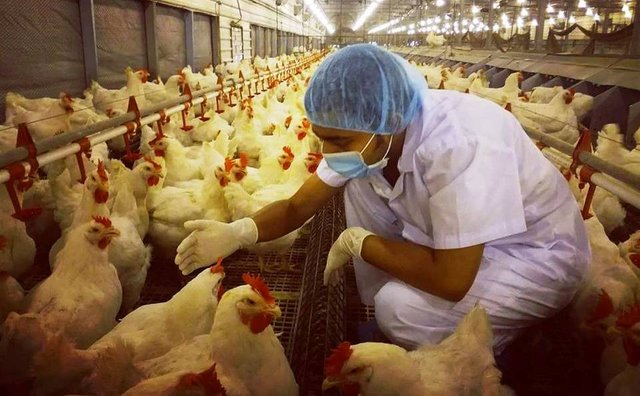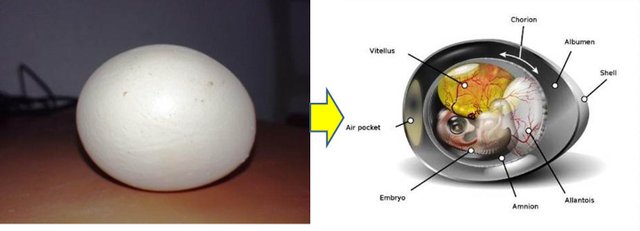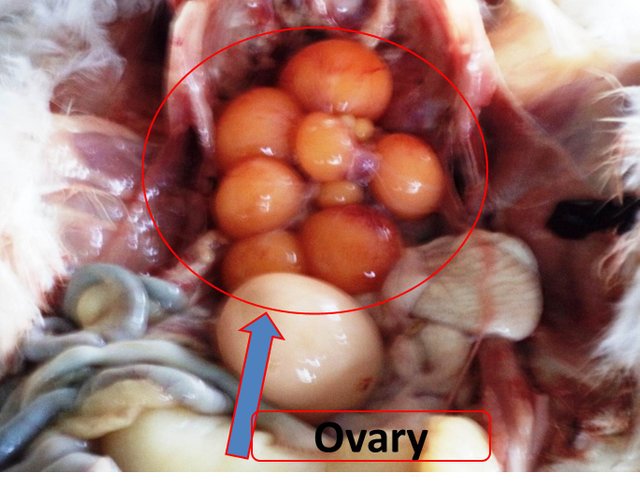Amazing Thing of Poultry Science! How does a Chicken Produced 14 Fertile Egg by a Single Mating??
Introduction:
Hello, jolly people of Steemit. How are you all? Hope you all well by the grace of almighty. Every day I try to make new informative content for you all. In continuation of the series, I write a blog in the title of “ Amazing Thing of Poultry Science! How does a Chicken can be Produced 14... Fertile Egg by a Single Mating?? ”

Basically, I am a science background student and I write this blog on the basis of my study and job experience. Now I am working in Poultry Breeder Farm as a Research & Production Officer. Here I notice a very interesting thing and obviously its egg fertility.
Which one has appeared first in this universe, chicken or Egg? But till now there is a conflict to answer this question. A group of people say the Hen arrived first in this universe and another group of people says, the Egg arrived before the Hen. That’s means till now we don’t get the mutual solution for this question. Here I am also through this question to audience Which one has appeared first in this universe, chicken or Egg? please leave a comment with your justification in replay section.
In poultry science, there are many amazing and mysterious question like this. Here I am going to discuss an interesting topic of poultry that “how does a Chicken Produce 14 Fertile Egg by a Single Mating?”
Generally, our mentality growing up with a concept that one mating one offspring like human, cattle buffalo. But some species it’s totally different and reproductive system not like human, cattle buffalo. From our normal sense, a poultry species name chicken possesses a speciality that’s why it's produced more than one fertile egg by a single mating or copulation. Do you know what’s the speciality possess that’s why poultry produce more than one fertile egg? Ok, no problem, Let me clear and answering this question?
This topic totally related to the chicken reproductive system. So if I want to clear this topic, at first you should know the female reproductive system of chicken.
Before starting the discussion I want to clear one thing although it is not related to this topic. In our locality or the rural area people addressing chicken or broiler as Poultry. But this concept is totally wrong. The term poultry represent domesticate avian species which are raised for egg, meat and feather production.
That means it can be said that poultry is a term which used to describe 11 avian species of those are Chicken, Duck, Pigeon, Quail, Turkey, Guinea fowl, Guinea fowl, Geese, Ostriches and Pheasants. I think now the poultry term is to be clear.
Now I leave this topic and move to my main discussion on the Female reproductive system of chicken.
Female Reproductive System:
The Chicken reproductive system may be defined as a system by which chicken formation egg. Here I mentioned egg because from the egg the day-old chick or next progeny produce. For making easier of our discussion we can divide a chicken reproductive system into two part- (1). Ovary (2).Oviduct
Before move into the final discussion it’s better to study about the egg structure . Because the following discussion we will get many new term which is related to egg structure.
Generally, we know that a single cell is very small and without the microscope, it is not visual. But you may be amazed to know that, although egg size is normally visual and big but it is a single cell. The shape egg is an oval or round shape. But if we described it anatomic view than we found following parts

Fig. Anatomical Structure of Egg First image by author and second Image Source
a).Egg shell: The first part of the egg which we notice, that is egg shell. Eggshell is uneven and grainy structure. It’s a amazing information that an egg shell hold approximately seventeen thousand spores. The chemical component of the eggshell is calcium carbonate (CaCo3). With this pore bacteria or other microorganism can enter inside the egg. The bloom or cuticle which is comes from vagina sealed this spore and prevent entering outside particle (dust, bacteria or other microorganism).
b).Membrane: It has two types of membrane name inner shell membrane and outer shell membrane. Outer shell membrane located just under the shell and inner shell membrane located between albumin and yolk. This membrane is made of protein and provide a strong support to egg that’s why outside particle cannot enter inside the egg.
c).Air sac: Air sac is a place where oxygen stored. It located the large end of the egg between the inner and outer shell membrane. the main task of air sac is to provide oxygen to developing an embryo. Air sac development depends on the age of the egg. It’s become larger with the increasing the age of the egg.
d).Albumen: the white portion of the egg is known as albumen. The albumin is consisting of more than 40 different types of protein. Along with this water, its holds a large amount of water.
e).Chalazae: another component name is chalazae. It acts as a rope inside the egg. It holds the yolk in the center of the egg.
f).Yolk: the last and central portion of the egg is the yolk. A membrane located just outside the egg is called Vitelline membrane. Yolk contains more protein, fat most of the vitamin and mineral. It also contains lecithin. The yolk color is whitish yellow yellow or deep orange. It depends on the feed component and breed of bird. Xanthophyll is the pigment which maintains the yolk color.
Although I keep the egg yolk part discussion at the last but yolk formation is the first step for the egg formation mechanism. Our Following discussion we will get, from where the egg formation is start.
(1). Ovary
The ovary is the first part of among two portions of a chicken reproductive system. The ovary is a bunch of growing ova (Ova singular form & Ovum Plural form). It contains approximately 10 to 1000 ova which turn from ova to yolk. This yolk leaves ovary and fall to the oviduct.

This process is called ovulation. Actually, while we break an egg, we notice yolk. This yolk comes from ova and it’s called germinal disc. Every species of bird (including poultry) only left ovary is functional.
Although the early stage of the chicken embryo has right ovary and oviduct in the adult stage of the bird is inactive. And this inactive oviduct is the main role to produce more than one fertile egg by a single mating. But curious mind wants to know how it’s happening? Don’t worry, the last part of the discussion you will get this answer.
(2).Oviduct
The second part of the chicken reproductive system is oviduct. After ovulation ova enter into the oviduct. Albumin and eggshell formation occurring in this part. Oviduct has four parts. Those are
a).Infundibulum b). Magnum c). Isthmus d). Uterus e).Vagina. These five parts have a different shape, length and role for an egg formation. Let's get to know what’s their contribution.
 Fig. Feamle Reproductive system (Except of overy , the rest portion is known as Oviduct Imagesource
Fig. Feamle Reproductive system (Except of overy , the rest portion is known as Oviduct Imagesource a).Infundibulum: Infundibulum is the first section of the oviduct. It holds funnel shape and length 7-9 cm (3-4 inch). After releasing yolk from ovary infundibulum hold the yolk. The yolk spends 15-17 minute time in this section. In his portion yolk come to touch in semen and makes itself fertilized.
b).Magnum: The second portion of infundibulum is Magnum. This is the largest portion of the infundibulum. It’s 33 cm (13 inches) long. The yolk remains here 3 hours and the white portion or thick albumen of egg formation here which makes a fence surrounded the egg yolk.
c).Isthmus: Isthmus is the third portion of Infundibulum and approximately 10.15 cm (4 inches) long. The main task of this fart is formation inner and outer shell membrane of eggs. The growing egg stays this section around 75 minutes.
d).Uterus: Uterus is the last portion of Infundibulum. It’s also known as shell gland and 9-12 cm (3-4 inch) long. The main task of this section is the formation of eggshell. The developing egg remains here around 20 hours.
e).Vagina: Vagina is the last portion of the oviduct. Actually, it has no role in egg formation. its just help to push the egg lay down. It,s around 9-12 cm (4-5 inches) long. The cuticle comes from the vagina which helps to close the spore of eggshell which prevents microorganism to penetrate on eggshell. The egg moves small end first in the whole oviduct. In the vagina, its turn and the large end comes out first.
The embryo or ova moves approximately 24-26 hour in the different part of the oviduct and finally comes out a shape of an egg.
Now it’s my time to answer the question which I make my heading that “How does a Chicken Produce 14 Fertile Egg by a Single Mating?? ” Before answering this question I one minute to talk over male reproductive system briefly. It makes the topic more clear
Male Reproductive System
The male reproductive system of chicken consists of 3 distinct parts. Those are a).Testicles b). Vas Deference c).Copulatory organ. Some brief description is given bellow about this organ given bellow.
a).Testicles: chicken has two testicles inside the body cavity. The sperm is produce form here. The tests also responsible for produce male hormone. The lighting program is directly related to chicken maturity and sperm production. In the controlled house, the male bird comes into maturity at 22-24 week of age. On the other hand in free range, the male chicken comes maturity at 17-18 week of age. By the way, spermatozoa produce from testicle and moves to the urethra by vas deference.

Fig. Male reproductive system
(1. Testes 2.Epididymis 3.Bladder 4.Rectum 5.Ureter 6.Vas Deferens 7.Genito - Urinary Sinus 8. Penis enclosed in a fibrous sheath 9.Cloaca 10. Opening in the ventral wall of the cloaca for the penis.) Image Source
b).Vas Deference: through epididymis and ureter sperm comes in vas difference. It isa very important part of the male reproductive system because the sperm store and gets maturity in this part. From here sperm go to the copulatory organ (penis).
c).Copulatory Organ: The chicken copulatory organ may be define as a organ by which a roster mate with a female bird. Generally, it is known as the penis.
The roster comes to close female birds and touch vagina by the penis.
In one mating roster or male chicken ejaculate approximately 0.35-0.5 ml semen. The sperm concentration of roster 4 billion/ml. But this semen volume is 10-15 times more than the requirement for fertilizing an egg.
How does a Chicken can be Produced 14 Fertile Egg by a Single Mating?
From the upper discussion, someone may get the answer ambiguously. In this section, I am trying to finalize the article and give the jest answer the question.
We get to know from female reproductive discussion part that semen is reserved on infundibulum section of the oviduct. Here semen remain more than 14 days with quality as like as like the semen which is coming out first from the male copulatory organ (Penis).
Here the ova or yolk come to touch in semen or sperm and ova become fertilize.
On the other hand, from discussion part of the Male reproductive system, we get to know that the volume of semen ejaculated by a roster /male bird is
10-15 times more than requirements for its single fertilization. For this reason, the chicken possesses this characteristic that Chicken Produce 14 Fertile Egg by a Single Mating.
Conclusion
Finally, we conclude that semen reserved capacity and enough semen production capacity is the main reason to produce more than one egg by a single successful mating. I don't know what exactly yet but it would give it more consistency.
Reference:
1.poultry kepper.com
2.Extension
3.Silencing
4.Wikimedia
5.FAO
6.exploratorium
7.The Poultry page
8. Food and Agriculturl Organization
A big Thanks to @alexdory for mentoring this article
Thanks a lot for reading My blog. Again will come with the next Blog with new Agricultural/ Animal Science content. Until then keep yourself healthy and Fit.

)
Hi there,
I enjoyed the idea of the article, mainly because as a child I spent time at my grandparents farm. We would traditionally roast and eat all the ova and the oviduct when sacrificing a chicken.
I enjoy seeing passionate people bringing their knowledge here as this subject is often neglected or purposely ignored by people.
As I have told you on Discord, adding more of your personal touch to the articles is welcome, as you can't improve much more on the physiology of poultry :D
I am sure that your update to this article, when made, will improve it and give it a chance to get voted.
Continue like this and you will make it here. I look forward to seeing your future content also, we can work together into finding a subject which can bring more value to Steem and give you a little more space for originality.
You really a helpful person indeed. I a very happy to get you on steemit. whatever I update my article please review my article and if any correction needed
DM please
Dear frnd
Amazing facts.. single mating and fourteen fertilized egg.
Yes my friend, go through the whole article , you will get many new thing from it
Congratulations @mawahab! You have completed the following achievement on the Steem blockchain and have been rewarded with new badge(s) :
Click on the badge to view your Board of Honor.
If you no longer want to receive notifications, reply to this comment with the word
STOPDo not miss the last post from @steemitboard:
Your post has been selected to be presented in Steemit Bangladesh Curation Competition Episode # 18 . If you are from Bangladesh and would like to present the article in the voice hangout during the competition, Please join the hangout on our Discord server.
Steemit Bangladesh Curation Competition Episode # 18
Time : 10 PM BDT
Date: 14/09/2018 (Friday)